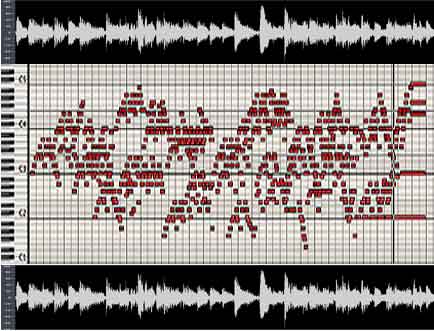
As home computers have dramatically grown in speed and capacity in recent years, there's been an explosion in the number and variety of computer based tools for musicians - everything from iTunes to music notation software; software to help learn Music Theory and to help train your ear, software to aid in studying and transcribing recordings, and much more. But probably the most significant developments in Music Technology have come in the areas of hardware and software for digital audio recording and MIDI sequencing.
If you own a computer then you already have the heart of a digital music workstation. All you need is a microphone, an electric guitar, or an inexpensive electronic keyboard, and all the capabilities of digital audio recording are available to you. Many free or inexpensive digital audio recording programs are available for both PCs and Macs. If you own a recent Apple computer then you already have one in Garageband. Digital audio gives you incredible flexibility in editing the music you record, and most programs (including Garageband) have built in effects such as reverb and chorus.
The sky's the limit as far as the sophistication of this type of software, depending on what you're willing to pay. You can record your next CD, your jam sessions, or your practice sessions, and keep all your recordings organized in iTunes.
MIDI stands for Musical Instrument Digital Interface. It was designed in the early 1980's as a language with which electronic musical instruments could communicate. If you own even an inexpensive electronic keyboard it probably has MIDI inputs and outputs, allowing you to use it as a MIDI "controller" to communicate musical notes and timing to your computer. With even the most minimal of keyboard skills you can play your ideas, performing them slowly or even piece-by-piece. Your keyboard controller converts what you play into "MIDI performance data" (think of it as sheet music for computers), and passes it to your computer, where it is "recorded" by MIDI sequencing software. The sequencer plays back your input as a seamless musical performance, at any tempo, as any one of a myriad of instrumental sounds. You can layer together many tracks, building up the sounds of a rock band, or of a symphony orchestra, editing down to the level of individual notes and their timings.
MIDI sequencing is an amazing tool. You can sketch out and develop your musical ideas, unleashing your imagination, and then easily share what you create with friends and fellow musicians. You can develop MIDI sequences to use as accompaniment for practicing your instrument, making practicing more interesting and challenging. The ability to play back your sequences at any tempo makes MIDI sequencing an ideal practice tool.
Digital audio recording and MIDI sequencing are often combined in one program (such as Garageband), and the combination gives musicians a powerful set of creative tools.
I have a Master of Science degree in Computer Science and teach the Intro to Technology in Music course at the Community College of Vermont in Winooski. I encourage my private guitar students to use all the computer-based tools at their disposal, and work to help them understand and use the tools. Whatever your instrument I'd be happy to show you how these tools work, and how you can incorporate them into your musical life.
The red dots in the image above are a MIDI "performance data" representation of the Fugue No. 1 from J. S. Bach's "Well Tempered Clavier, Part 1". Above and below the performance data are waveform representations or an audio recording of the fugue.